Understanding Lordosis- Types, Causes and Treatment
, 8 months ago
Lordosis refers to spinal curvature or normal spinal alignment. There is a deep curve in the lower part of the spine due to which the abdomen protrudes out and the hip area recedes backwards. These extreme curve changes occur due to bad posture, spine diseases, injury, surgery of the spine, or genes transferred from parents. This article will provide you with a complete overview of what is lordosis, its types, symptoms, causes, and treatment.
Types of Lordosis
There are five types of lordosis:
It is a common type that occurs due to obesity. There is an imbalance of the muscles of the stomach and back. Due to excessive weight in the stomach area, the back is pulled forward. The muscles of the stomach and back become weak and cannot support the spine. Excessive weight pulls the spine to curve forward.
- Post-Surgical Laminectomy Hyperlordosis
Laminectomy is a surgery done to remove some vertebrae from the spine to remove pressure on the nerves. This makes the spine unstable and causes hyperlordosis. Hyperlordosis means the spinal curve is increased. It is generally found when someone goes under surgery to remove tumours from the spine.
- Congenital or Traumatic Lordosis
Any injury or trauma to the spine can cause back pain in the lower part. It is often found in children or athletes who suffer from traumatic injury while playing sports. The connections between the spine become weak and become ill-shaped and weak. If proper rest is not taken, the vertebrae slip forward, pressing the nerves. This causes numbness, pain, tingling, and weakness in the legs.
- Lordosis Due to Hip Flexion Contracture
It is a rare type of lordosis that occurs due to contracture of the hip joint. This disturbs the normal spinal alignment and causes back pain.
Neuromuscular lordosis includes different types of disorders and can cause various types of spinal curvature disorders.
Types Based on the Part of the Spine Affected
Based on the part of the spine affected, there are two types:
In cervical lordosis, the neck or cervical region of the spine is affected. There are seven vertebrae in the cervical spine. The neck is pushed forward more than normal and causes pain in the neck.
It is called swayback. In lumbar lordosis, the hips and pelvis move forward. The stomach sticks out, and the hips stick behind.
Causes of Lordosis
In most cases, lordosis does not have a cause. It develops over time. Lumbar lordosis has no cause. This is noticed in people with increased kyphosis. Other health problems that can cause lordosis are:
Symptoms of Lordosis
Some people do not experience any symptoms of lordosis. They never know until they are diagnosed by a doctor. The postural deformity may be noticed by other people. In chronic cases, people may have the following symptoms:
Difficulty in walking or standing for a long time.
Postural defects such as the head neck leaning forward more than normal, hips getting pushed forward, butt sticking out, and there is more space in the lower back when lying down.
Treatment of Lordosis
Treatment of lordosis
is based on the severity of spinal alignment and the underlying causes of lordosis
. Treatment of lordosis
includes the following:
A physiotherapist at the QI Spine Clinic can suggest the best possible exercises to enhance the strength of the muscles that support the spine. Exercise will help to support the abdominal and lower back muscles. Other physical therapies such as massage and spinal manipulation can also help to enhance movement and reduce pain.
The orthopaedic doctors at the QI spine clinic are trained to improve posture by using ergonomic adjustments. They can help patients to maintain a neutral spine position while standing or sitting. The orthopaedic doctor can also suggest exercises to enhance the strength of core muscles for proper spinal alignment.
Braces may be advised in some cases. This will help to restore the normal spinal alignment.
If there is inflammation in the back muscles or back pain, the doctor may prescribe non-steroidal anti-inflammatory medications to reduce pain and inflammation in the back.
Surgery is done in severe cases. When other methods of treatment do not give relief to the patients, then surgery is recommended. Surgical treatment includes decompression, spinal fusion, and corrective osteotomy to improve spinal alignment and stabilise the spine.
Conclusion
Lordosis
is a postural defect and it causes misalignment of the spine. It is of different types depending on the cause and area affected. A proper diagnosis is required for getting the best treatment for which you should consult the QI Spine specialists. Non-invasive treatments such as physical exercises, massage therapy, lifestyle modifications, and postural correction can help in some cases. In severe cases, surgical intervention is required to correct the spinal curvature.

